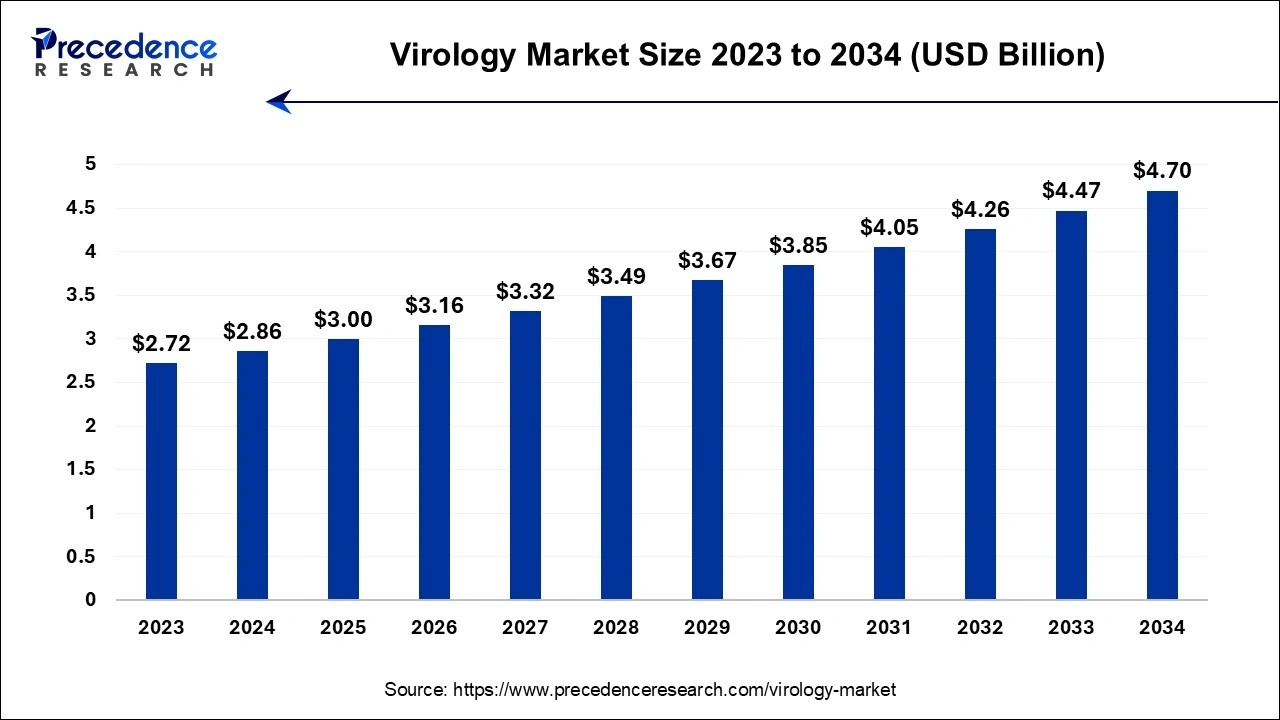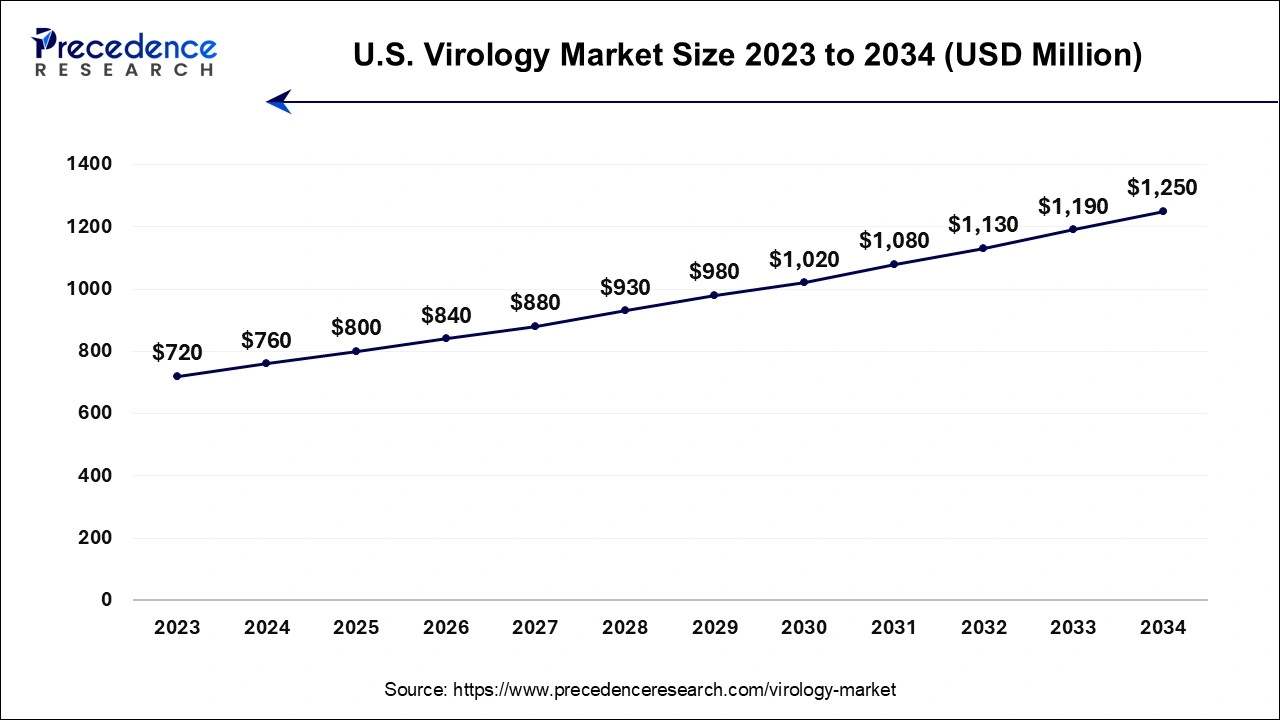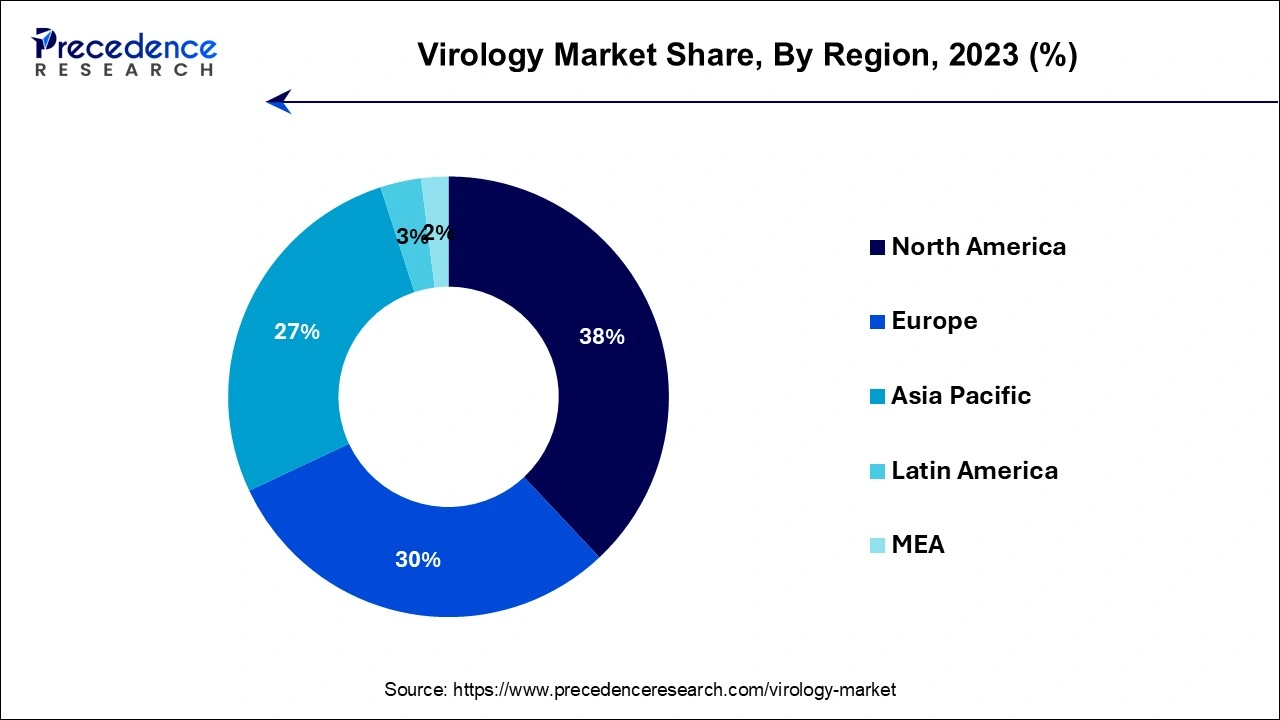List of Contents
Virology Market Size and Forecast 2024 to 2034
The global virology market size accounted for USD 2.86 billion in 2024 and is anticipated to reach around USD 4.70 billion by 2034, representing a notable CAGR of 5.10% between 2024 and 2034.

Virology Market Key Takeaways
- North America led the market with the biggest market share of 38% in 2023.
- Asia-Pacific is projected to expand at the fastest CAGR during the forecast period.
- By Product Type, the antiviral therapeutics segment has held the largest revenue share of 45% in 2023.
- By Product Type, the interferons segment is anticipated to grow at a notable CAGR of 6.7% during the projected period.
- By Application, the respiratory tract infections segment contributed more than 36% of revenue share in 2023.
- By Application, the eye infections segment is estimated to expand at the fastest CAGR over the projected period.
- By End User, the hospitals segment has held the largest revenue share 30% in 2023.
- By End User, the diagnostic centers segment is expected to grow at a CAGR of 7.9% over the predicted period.
U.S. Virology Market Size and Growth 2024 to 2034
The U.S. virology market size accounted for USD 760 million in 2024 and is expected to be worth around USD 1250 million by 2034, at a CAGR of 5.20% during the forecast period from 2024 to 2034.

North America has held the largest revenue share 38% in 2023. North America commands a substantial share in the virology market due to several key factors. The region boasts advanced healthcare infrastructure, robust research and development capabilities, and significant investments in virology research. Moreover, North America has been at the forefront of the fight against viral diseases, with a high demand for diagnostic tests, antiviral therapies, and vaccines. The COVID-19 pandemic further accelerated market growth, as North American companies played pivotal roles in vaccine development and production. Additionally, government support and public health initiatives have bolstered the region's position as a leader in virology, ensuring a major market share.

Asia-Pacific is estimated to observe the fastest expansion. Asia-Pacific holds substantial growth in the virology market for several compelling reasons. Its vast and diverse population makes it particularly susceptible to a wide spectrum of viral infections, resulting in a consistent demand for virology-related solutions. Moreover, the region's emerging economies are significantly expanding their healthcare infrastructure and research and development investments. Asia-Pacific has also played a prominent role in responding to viral outbreaks such as SARS and COVID-19, cultivating expertise and fostering innovation in the field of virology. These factors, coupled with an increasing awareness of viral diseases, firmly establish Asia-Pacific as a major player in the virology market.
Market Overview
The virology market encompasses the global industry focused on the study, diagnosis, treatment, and prevention of viral infections. It includes research, pharmaceuticals, diagnostic tests, and vaccines related to viruses. The market has seen substantial growth due to emerging viral threats, such as HIV, influenza, and the COVID-19 pandemic, driving research and development efforts. Diagnostic technologies, antiviral drugs, and vaccine development constitute significant segments of the virology market. Additionally, public health initiatives and government investments play a crucial role in shaping the market's dynamics. With the ongoing challenges posed by viral diseases, the virology market continues to evolve and expand.
Growth Factors
The virology market is a dynamic sector encompassing the study, diagnosis, treatment, and prevention of viral infections. Its growth is fueled by several key factors and trends. The emergence of novel viral threats, like HIV, influenza, and the COVID-19 pandemic, has spurred increased investment in research and development efforts, creating opportunities for innovation. The development of advanced diagnostic technologies has also contributed to market expansion, enabling faster and more accurate virus detection.
Antiviral drug development is another significant segment within the virology market, with ongoing efforts to combat viral infections and reduce their impact. Additionally, the quest for effective vaccines to prevent viral diseases has driven growth, with the COVID-19 vaccine development and distribution serving as a recent and prominent example. Government investments and public health initiatives have played a pivotal role in shaping the industry landscape, especially during health crises.
However, the virology market is not without challenges. The rapid mutation rates of many viruses pose hurdles for drug and vaccine development, necessitating ongoing research and adaptability. Regulatory processes for new treatments and vaccines can be lengthy and complex, hindering market growth. Furthermore, ensuring equitable access to antiviral drugs and vaccines remains a global challenge, highlighting the need for more inclusive approaches.
Despite these challenges, the virology market offers significant business opportunities. Continued research into antiviral therapies and innovative diagnostic tools holds promise for market expansion. The COVID-19 pandemic has highlighted the importance of preparedness and response, creating a heightened awareness of the value of virology research. Collaborations between pharmaceutical companies, research institutions, and governments can lead to breakthroughs in virus control and treatment, fostering growth and market advancement.
In conclusion, the virology market is a dynamic sector driven by emerging viral threats, and advancements in diagnostics, drug development, and vaccine research. While it faces challenges related to viral mutations, regulatory processes, and equitable access, there are ample opportunities for innovation and expansion through collaborative efforts and ongoing research initiatives, especially in the wake of the COVID-19 pandemic.
Market Scope
| Report Coverage | Details |
| Growth Rate from 2024 to 2034 | CAGR of 5.10% |
| Market Size in 2024 | USD 2.86 Billion |
| Market Size by 2034 | USD 4.70 Billion |
| Largest Market | North America |
| Base Year | 2023 |
| Forecast Period | 2024 to 2034 |
| Segments Covered | Product Type, Application, End User, and Region |
| Regions Covered | North America, Europe, Asia-Pacific, Latin America, and Middle East & Africa |
Market Dynamics
Driver
Vaccine research and development
Vaccine research and development are pivotal drivers of the virology market's robust growth. The urgent global demand for effective vaccines, exemplified by the rapid development and deployment of COVID-19 vaccines, has catalyzed unprecedented investments in virology. This surge in funding and scientific focus has accelerated the development of vaccines not only for novel viral threats but also for existing ones like influenza, hepatitis, and HIV. The continuous evolution of vaccine technology, including mRNA and vector-based platforms, has broadened the scope of virology research and enhanced our ability to create vaccines with improved efficacy and safety profiles.
Furthermore, the need for booster shots and ongoing vaccine research to combat emerging variants of viruses ensures a sustained demand for virology products and expertise. The virology market benefits from collaborations between governments, pharmaceutical companies, and research institutions, fostering innovation and expediting vaccine development. This synergy between science, industry, and public health initiatives amplifies the virology market's growth potential, making it a cornerstone in global efforts to combat viral diseases and promote public health.
Restraints
Viral mutations
Viral mutations present a significant restraint on the growth of the virology market. Viruses, particularly RNA viruses like HIV, influenza, and SARS-CoV-2 (responsible for COVID-19), have a remarkable capacity to mutate and evolve rapidly. These mutations can result in the emergence of new strains or variants, some of which may exhibit increased transmissibility, altered disease severity, or reduced susceptibility to existing treatments and vaccines.
The constant evolution of viruses necessitates ongoing research and adaptation in the virology field. This means that virologists, pharmaceutical companies, and researchers must continuously develop and update diagnostic tests, treatments, and vaccines to remain effective against new viral variants. These endeavors are resource-intensive and time-consuming, posing a financial and logistical burden on the virology market.
Additionally, the unpredictability of viral mutations can disrupt long-term strategies and investments in the virology sector, making it challenging to anticipate and address emerging threats. In essence, viral mutations compel the virology market to remain in a perpetual state of vigilance and adaptation, which can hinder its overall growth and stability.
Opportunities
Antiviral therapies
Antiviral therapies are instrumental in shaping opportunities within the virology market. As viral diseases continue to pose a global challenge, the development of inventive antiviral treatments has emerged as a catalyst for growth. This sector presents substantial prospects, offering the potential to create new medications targeting a diverse array of viral infections, encompassing persistent afflictions such as HIV and hepatitis, as well as emergent viral menaces like coronaviruses.
Furthermore, advancements in drug delivery mechanisms and the adoption of personalized medicine strategies enhance the effectiveness and safety profile of antiviral therapies, generating additional avenues for market expansion. Collaborative ventures involving pharmaceutical firms, research entities, and governmental bodies can expedite the research, development, and dissemination of these therapeutic solutions. Moreover, the escalating emphasis on global health and readiness for pandemics has spurred investments in antiviral research, firmly establishing it as a basis of the virology market's growth and a vital component in the ongoing fight against viral ailments.
Impact of COVID-19
The COVID-19 pandemic has profoundly impacted the virology market. It accelerated research, development, and production of diagnostic tests, vaccines, and antiviral therapies. Pharmaceutical companies and research institutions collaborated intensively, leading to rapid vaccine development and distribution. Public health initiatives and government investments surged, highlighting the importance of virology in pandemic preparedness. Telemedicine and remote monitoring gained prominence, transforming patient care. However, supply chain disruptions and competition for resources posed challenges. The pandemic underscored the virology market's critical role in global health, driving innovation, increased funding, and heightened awareness of the importance of virology research and solutions.
Product Type Insights
According to the product type, the antiviral therapeutics segment has held a 45% revenue share in 2023. The Antiviral Therapeutics segment commands a significant share in the virology market due to its crucial role in combating viral infections. Antiviral drugs are a cornerstone in managing chronic conditions like HIV, hepatitis, and herpes while also offering potential treatments for emerging viral threats like coronaviruses. Continued research and innovation in this field have led to the development of effective, targeted therapies, driving demand. Additionally, the ongoing pursuit of treatments for viral diseases and the adaptability of antiviral drugs to address evolving viral strains solidify this segment's prominence in the virology market.
The interferons segment is anticipated to expand at a significant CAGR of 6.7% during the projected period. The Interferons segment holds significant growth in the virology market due to its crucial role in antiviral defense. Interferons are innate immune system proteins that activate a robust antiviral response when a viral infection is detected, inhibiting viral replication. They are utilized in the treatment of various viral infections, including hepatitis, HIV, and certain forms of cancer linked to viral triggers. With their proven efficacy and versatility, interferons remain a cornerstone of antiviral therapies, contributing to their substantial growth in the virology market as a widely recognized and established treatment option.
Application Insights
In 2023, the respiratory tract infections segment had the highest market share of 36% on the basis of the Application. The respiratory tract infections domain wields a substantial influence within the virology market, primarily due to the pervasive prevalence of respiratory viruses, encompassing influenza, respiratory syncytial virus (RSV), and coronaviruses. These viral afflictions pose a formidable global healthcare challenge, propelling a robust demand for diagnostic apparatus, vaccines, and antiviral remedies. Furthermore, the advent of novel respiratory viruses, like the SARS-CoV-2 responsible for the COVID-19 pandemic, has further accentuated the pivotal significance of this sector. Sustained research, pioneering innovations, and the continual evolution of diagnostic techniques and vaccine formulations for respiratory infections collectively underpin the commanding presence of this category in the intricate landscape of the virology market.
The eye infections are anticipated to expand at the fastest rate over the projected period. The eye infections segment commands substantial growth in the virology market due to the prevalence of viral infections affecting the ocular system. Viral eye infections, including conjunctivitis and herpes keratitis, are widespread and can result in serious complications without proper intervention. This segment's prominence is driven by the continuous need for efficient diagnostic tools and antiviral treatments in ophthalmology. Furthermore, ongoing innovations in the field of eye infection research and the creation of specialized therapies have propelled the significant growth of this segment, establishing it as a crucial component within the broader virology market.
End User Insights
The hospitals segment held the largest revenue share of 30% in 2023. Hospitals hold a significant share in the virology market due to their central role in healthcare delivery. They are key hubs for diagnosing, treating, and managing viral infections, making them major consumers of virology-related products and services. Hospitals frequently conduct routine testing, handle outbreaks, and provide critical care during pandemics. They require a wide range of virology solutions, from diagnostic assays and equipment to antiviral drugs and vaccines. Additionally, the COVID-19 pandemic further emphasized the importance of hospitals in virology, driving up demand for testing and treatment resources, and solidifying their dominant position in the market.
The diagnostic centers segment is anticipated to grow at a significantly faster rate, registering a CAGR of 7.9% over the predicted period. Diagnostic centers hold significant growth in the virology market due to their pivotal role in early virus detection and monitoring. They offer a wide range of diagnostic tests, including PCR, serology, and molecular assays, allowing for accurate and rapid virus identification. The COVID-19 pandemic further boosted the demand for diagnostic services. Additionally, these centers serve as crucial hubs for disease surveillance and tracking, playing a vital role in public health responses. As a result, the diagnostic centers segment remains a cornerstone of the virology market, ensuring timely diagnoses and informed decision-making in the management of viral diseases.
Virology Market Companies
- GlaxoSmithKline plc
- Abbott Laboratories
- Boehringer Ingelheim Corporation
- Merck and Co. Inc.
- Novartis International AG
- Siemens
- Johnson & Johnson
- AstraZeneca AB
- Roche
- Trinity Biotech
Recent Developments
- In May 2022,QuantuMDx Group Limited introduced its latest respiratory panel test, the Q-POC SARS-CoV-2, Flu A/B & RSV Assay. This innovative assay is designed to operate on the Q-POC platform, which boasts multiplex capabilities. This advancement enables users to conduct swift point-of-care testing in various settings, whether clinical or non-clinical.
- In January 2022, InTec made headlines with the unveiling of its novel and highly sensitive SARS-CoV-2 Rapid Antigen Test, known as the AQ+ Covid-19 Ag Rapid Test. Specifically developed for professional use, this test empowers healthcare professionals and even laypersons to swiftly and conveniently identify COVID-19 cases.
Segments Covered in the Report
By Product Type
- Diagnosing Test
- Viral Infection Controlling Methods
- Antiviral Chemotherapy
- Interferons
By Application
- Skin and Soft Tissue Infections
- Respiratory Tract Infections
- GI Tract Infections
- Urinary Tract Infections
- Eye Infections
- CNS Infections
- Sexually Transmitted Diseases
- Perinatal Infections
By End User
- Hospitals
- Clinics
- Laboratories
- Diagnostic Centers
- Blood Banks
- Pharmacies
By Geography
- North America
- Europe
- Asia-Pacific
- Latin America
- Middle East and Africa
For inquiries regarding discounts, bulk purchases, or customization requests, please contact us at sales@precedenceresearch.com
Frequently Asked Questions
Ask For Sample
No cookie-cutter, only authentic analysis – take the 1st step to become a Precedence Research client